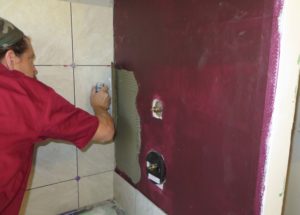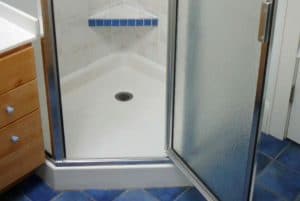Q: My contractor wants to use mastic, rather than thinset mortar, on our new shower stall – on both the shower base and the walls. He says that the mastic he uses is approved for wet areas. From what we’ve read and heard, thinset is the way to go. Also, we are considering a one-piece acrylic shower base vs. a tiled base. What do you recommend? – J.G.
A: Never use tile mastic in a wet area. I haven’t seen mastic used by any tile contractor in any application in many years. While mastic might be OK for light-duty dry applications like a decorative backsplash in a dry area, it is not suitable for wet areas, floors, hearths, exteriors, or most tile uses.
In wet areas, mastic will emulsify from any moisture penetration, which is likely to occur over time. Tile and grout do not create a fully waterproof surface. Even without hairline cracks, moisture can penetrate through grout. With any cracks in the grout or tile, liquid water will get through.
Also, mastic is also not as strong as thin-set and gets brittle and weak over time. It’s cheap and easy to use, but not a professional-grade product.
Tile in Wet Areas
In wet areas, it’s best to apply a waterproofing membrane to the tile backer before applying thin-set. Either sheet membranes or trowel-on liquid membranes (photo below) are recommended. The membranes protect the structure from moisture damage and most also serve as an “isolation membrane.” Isolation membranes help protect the tile and grout from cracking due to building movement – a normal feature of modern residential construction.

In general, modified thinset (with acrylic or other polymer additives) is stronger and more flexible than unmodified thinset. But some backers and membranes require one or the other material. Make sure the thinset is compatible with the tile backer and membrane. Basically, read and follow the instructions. It matters with these products.
Tile Shower Base vs Acrylic Base
As for the tile base, I like one-piece acrylic bases and have used them on a number of jobs. Tile bases are attractive, but difficult to build and tile correctly, and not all contractors have the necessary knowledge and skills. For a tile base to work well, you need a very firm base set in wet mortar, sufficient slope to the drain, and a properly detailed drain. Once that’s in place, you need a good waterproofing membrane, tiles well bedded in thinset, and a good grouting job, as well as a grout sealer.
In my experience, general contractors who do the occasional tile job themselves are often over their heads when it comes to a shower base. It’s better left to a expert tile contractors.
In comparison, an acrylic base is pretty foolproof. Like any fiberglass or acrylic tub or shower, the base must be set level and well supported by wet mortar so it does not flex when weight is applied. But, otherwise, it is easy to install and easy to maintain (photo below).

Unlike fiberglass, which has a thin gel coat, acrylic is a solid material with color all the way through. Small scratches can be polished or sanded out if necessary, and larger dings are also repairable with repair kits. If you don’t mind the appearance of an acrylic base, it’s a good way to go. — Steve Bliss, BuildingAdvisor.com
Leave a Reply